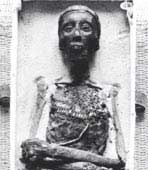The genitalia of the famous Pharaoh Tutankhamun has been found after decades of being missing. This event could help the king stand out in the world of mummified men.
 |
Photo of the Tutankhamun mummy. (Image: Discovery) |
The complete mummy of King Tut was documented in photographs by Harry Burton (1879-1940) during the excavation in 1922. However, by 1968, the king’s “privates” mysteriously disappeared when British scientist Ronald Harrison X-rayed the mummy. It is speculated that the body part was stolen and sold.
“In fact, it was always there. I found it during the CT scan last year, when the mummy was moved. It lay exposed under the sand next to the body“, said Zahi Hawass, Egypt’s leading archaeologist.
At first glance, Burton’s images suggest that King Tut’s “privates” appear larger than average. However, according to mummy expert Eduard Egarter Vigl, the pharaoh’s size was average.
“The pharaoh’s genitalia is clearly visible in Burton’s picture. Everything is normal with King Tut. The penis is a body part with many blood vessels, so it often shrinks when embalmed. In fact, King Tut’s ‘privates’ were ‘enhanced’ by the art of mummification“, Egarter explained.
Meanwhile, the natural mummification by ice of the Iceman Ötzi on the Alpine mountains resulted in this individual’s genitalia being retracted, leading to the appearance of no longer having masculine traits.
King Tut ascended to the throne in 1333 BC at the age of 9 and died in 1325 BC. He married his half-sister, Ankhesenpaaten, who was 13 years old, and they had two daughters, both of whom died in infancy.
M.T.




















































